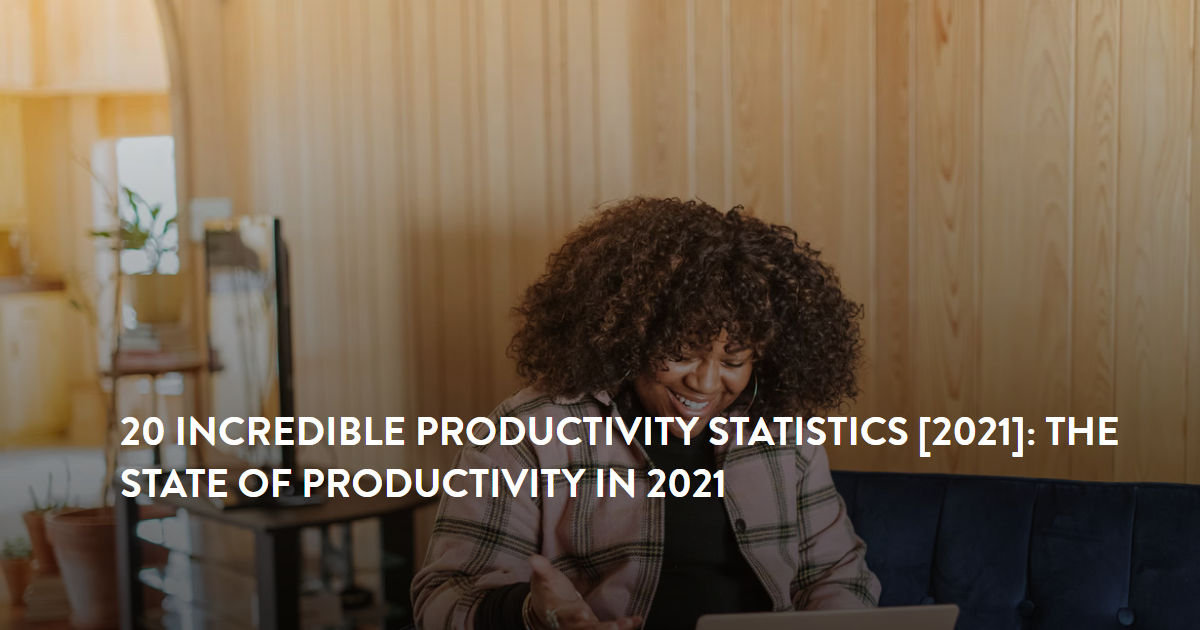- HR Statistics
- Average Labor Cost Percent Of Sales
- Average Time to Reach Profitability At A Startup
- Office Space Per Employee
- Recruitment Statistics
- Employee Engagement Statistics
- Work-Life Balance Statistics
- BYOD Statistics
- Paternity Leave Statistics
- Onboarding Statistics
- Average Paid Maternity Leave In Us
- Average Cost Of A Bad Hire
- Employee Theft Statistics
- Paid Family Leave Statistics
- Cost Of Hiring Statistics
- Employee Turnover Statistics
- Average Cost Of Employer Sponsored Health Insurance Statistics
- Sexual Harassment In The Workplace Statistics
- HR Statistics
- PTO Statistics
- Social Media Recruitment Statistics
- Hiring Statistics
- Out Of Prison Employment Statistics
Research Summary. With an abundance of job search websites and social media platforms available to us, you’d be surprised to know just how many job seekers are considered passive. Generally speaking, recruiters are what companies need to tap into this potential. But, how important are they really? According to our extensive research:
-
73% of potential candidates are passive job seekers who are currently employed and open to hearing about new job opportunities but also too hesitant to apply.
-
94% of hiring professionals that use ATS report that the software has improved their hiring process.
-
The average job vacancy costs a company $98 per day.
-
It takes an average of 42 days to fill a position.
-
60% of candidates will quit in the middle of applying for a job online due to a lengthy or overly complex application form.
-
Top candidates are only on the job market for ten days, on average.
For further analysis, we broke down the data in the following ways:
Recruitment Strategies | Job Seekers | Trends + Projections | Recruitment Challenges

General Recruitment Statistics
When most candidates are passive job seekers, it’s important to evaluate that in the context of recruitment. On a basic level, what does recruitment look like? Here are some insights our research uncovered:
-
73% of potential candidates are passive job seekers.
And a considerable 87% of these candidates are open to the new job opportunities provided by active recruitment.
-
The average job vacancy length is 42 days.
Whereas the average job listing is only active for up to 30 days. At 42 days, the average cost of a vacancy amounts to $4,129 in losses.
-
Only half of employers make use of ATS (Applicant Tracking Software).
However, of the 50% who use ATS, at least 78% report that it makes hiring candidates “easier than ever.”
Recruitment Statistics by Strategy
There are a variety of strategies recruiters use to outshine other companies and online job posting websites. Luckily, with 73% of their candidates being passive job seekers, there’s a lot of potential. Here’s how recruiters tap into that potential:
-
84% of companies use social media for recruiting.
With the average job levels recruited through social media being 87% non-management salaried employees, 82% being management, 55% being non-management hourly employees, and only 45% being executive or upper management employees.
-
70% of job seekers want to hear about their potential salary range in the first message from a recruiter.
That means there’s value in being upfront with the salary range, especially considering the fact that money is the deciding motivator for 67% of job seekers. Recruiters can easily lose engagement when they aren’t upfront with potential salaries.
-
88% of businesses report that their best hires are referrals.
Luckily, referrals are also very accessible for companies. For example, potential candidates are 46% more likely to accept InMails when they’re referrals from your current employees. Further, a considerable 65% of contingent workers found jobs through referrals.
-
Strong employer branding reduces the cost of recruiting by 43%.
Further, having a strong company brand also reduces turnover by 28%. This is unsurprising, given that nearly 50% of workers won’t work for an organization with a bad reputation.
-
39% of companies using contingent workers rely on direct sourcing to find their candidates.
And interest in direct sourcing continues to grow, as 23% of companies plan to implement direct sourcing as time goes on. The main reason for this increased interest is the benefits, as direct sourcing can speed up the hiring process and reduce hiring costs by up to 30%.
-
Companies can have a talent pool that’s 10x bigger by recruiting through their employees’ networks.
Luckily, most employees are also willing to do this free of compensation. The vast majority, 67%, will refer to help their friends or their company, while only 6% do it for money and recognition.
-
89% of applicants accept job offers faster when a recruiter contacts them.
And that can save companies a lot of money, given that the average job vacancy costs $98 per day.
-
Social professional networks are the #1 source of quality hires.
And of the social media sites used to network, LinkedIn is by far one of the most important. For instance, over 75% of people who’ve recently changed jobs used LinkedIn as a deciding factor.
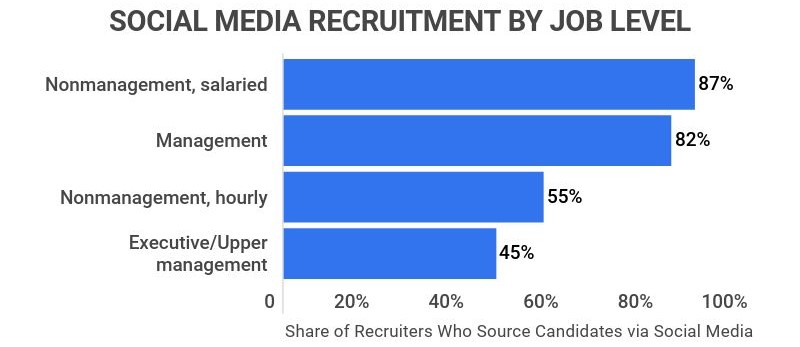
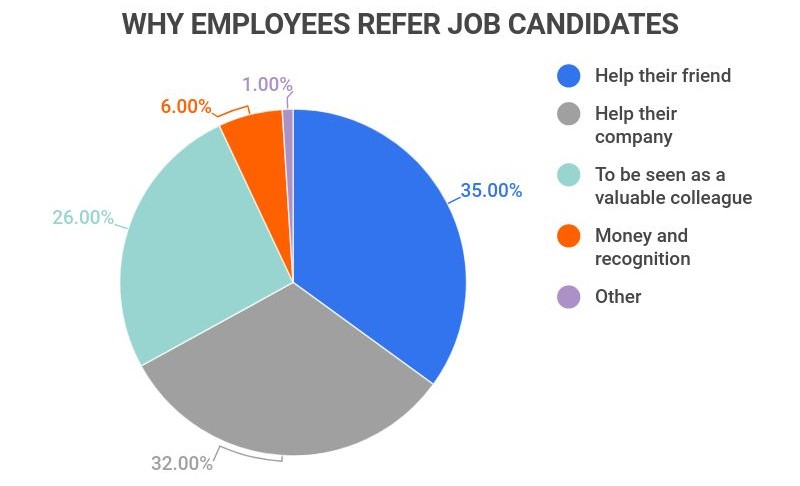
Recruitment Statistics by Job Seekers
On the other side of the recruitment coin are job seekers whose preferences and behaviors are at the root of any successful recruitment. Our research shows that:
-
52% of workers considered changing jobs in 2021.
While 44% had actual plans in place to make the switch. This is significant, as that means half of the entire workforce could be swayed by a recruiter.
-
Cultural fit accounts for around 10% of a hiring decision.
Whereas the other 90% is made up of things like skills and abilities. However, not every field and job is equal. For example, in tech firms, up to 59% of recruiters have reported rejecting a candidate because they lacked cultural fit.
-
At least 50% of job seekers are most frustrated by a lack of salary transparency.
This is, by far, the most frustrating aspect of job searching for the majority of job seekers. Other common gripes include canceled or postponed interviews and ghosting.
The chart below shows other common reasons why candidates remove themselves from the recruitment process.
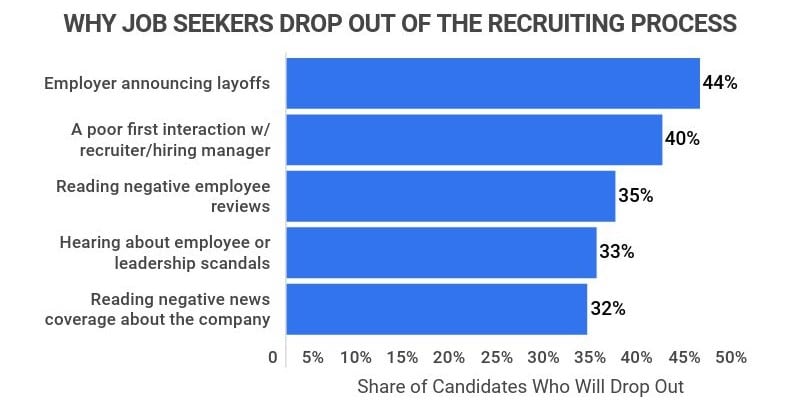
-
79% of applicants use social media when job searching.
And overall, social media plays a vital role in how an applicant will be perceived by the employer. For instance, 21% of employers are not likely to consider a candidate without a social media presence, and 54% have ruled out a candidate because they found something on their social media profile that they didn’t agree with.
-
41% of candidates rely on job boards to discover new jobs.
However, up to 80% of jobs are filled by personal and professional connections, and roughly 70% of people received their current company position through networking.
-
At least 45% of applicants apply for jobs online.
However, this number will likely increase over time, seeing as there has been a 460% increase in the search for remote jobs during the COVID-19 pandemic.
-
94% of job-seekers have used a smartphone to browse or research job openings.
Mobile usage is up in almost all areas of life, including the job search space. Job seekers aren’t just browsing a few jobs, either. About 3/4 have sent mobiles emails during the recruitment process, and about half of candidates have actually filled out an entire job application via mobile.
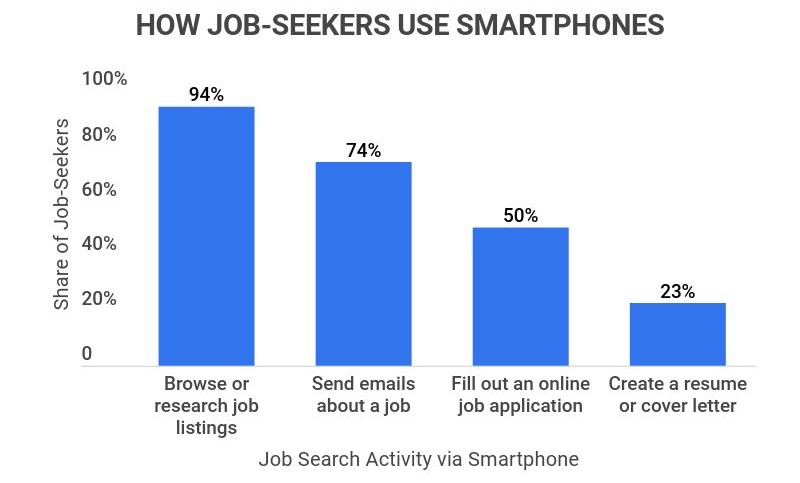
Recruitment Trends and Projections
It’s clear to see the importance of recruitment now, but where will it be heading in the future? The fact is that with the increase in online activity and remote work, recruiting must evolve. Here are the facts:
-
68% of recruiters agree that the best way to improve recruiting performance over the next five years is to invest in new recruiting technology.
And this trend toward technology is unsurprising, given that 94% of recruiters claim that using recruitment software has positively impacted their hiring process.
-
Due to the COVID-19 Pandemic, 70% of professionals now say virtual recruiting will become the new standard.
Further, 81% agree that virtual recruiting will continue post-Covid. This idea also bleeds into interviews, which are currently 86% virtual.
-
77% of professionals agree that diversity will be a crucial factor in the future of recruiting.
Luckily, the increase in remote interviewing and work seems to be pushing this agenda in a positive direction. For instance, researchers suggest that remote work will help boost geographical diversity among applicants by 20%.
Recruitment Statistics by Common Issues
Of course, every hiring system comes with its downsides. Recruiting is no different. Here are some of the negative trends we found associated with recruiting:
-
A considerable 75% of recruiters have experienced candidates changing their minds before being hired.
And a majority of candidate drop-outs can be attributed to the lengthy hiring process. The recruiting process can take 42 days, give or take, while experts suggest nailing a candidate down in 10 days to avoid losing them to competition.
-
39% of candidates who decline a job do so because they received another job offer.
Overall, at least 74% of recruiters face hiring competition. Again, much of this is connected to the sheer length of time it takes to hire a candidate. If someone has been waiting 15 days to hear back from a recruiter, they’re more than likely to accept that immediate job proposal they received yesterday.
-
At least 72% of employers find it difficult to acquire skilled candidates.
That means that 7/10 companies are finding it difficult to hire skilled candidates. Plus, these numbers are actually at a 15-year high.
Recruitment Statistics FAQ
-
Is recruiting a dying industry?
No, recruiting is definitely not a dying industry. In fact, because 72% of employers struggle to find skilled candidates, recruitment stands to become an even more important role. With it, companies can more easily tap into the 73% of potential candidates who are passive job seekers, as well as try to pull the limited talent pool away from the competition.
-
What is the average time to hire in 2021?
The average time to hire in 2021 is 42 days. Similarly, the average job listing is only active for up to 30 days. This can have major cost implications for companies, at an average of $98 in losses per day.
-
What are the latest trends in recruitment?
The latest trends in recruitment revolve around remote hiring/work, diversity challenges, and the implementation of technology.
For instance, 68% of recruiters agree that the best way to improve recruiting performance over the next five years is to invest in new recruiting technology, and this goes hand-in-hand with the fact that 70% of professionals now say virtual recruiting will become the new standard.
On the topic of diversity, 77% of professionals agree that diversity will be a crucial factor in the future of recruiting. Remote work will also play a role in this, as researchers suggest it will help boost geographical diversity among applicants by 20%.
-
What are the best recruitment strategies?
The best recruitment strategies involve salary transparency, as well as making use of referrals and social media.
For example, 84% of companies use social media for recruiting, 70% of job seekers want to hear about their potential salary range in the first message from a recruiter, and 88% of businesses report that their best hires are referrals.
-
What are recruitment ratios?
Recruitment ratios are simple but important metrics that recruiters and hiring managers use to track the success of their recruitment methods. Three commonly used recruitment ratios include:
-
Selection ratio. The number of people you hired divided by the total number of applicants. So if 100 people apply for a job and you hire 10, your selection ratio is 10:1.
-
Interview to hire ratio. The number of interviews you conducted divided by the total number of hires. So if you interview 8 people and hire 2, your interview-to-hire ratio is 4:1.
-
Success ratio. The number of successful candidates divided by the total number of candidates hierd. So if you hired 10 people and 9 of them are successful, your success ratio is 9:1.
Collectively, these ratios can help determine strengths and weaknesses in a recruiter’s endeavors. A high selection ratio might seem like a good thing, but if it comes at the expense of a poor success ratio, you’ll need to look at ways to improve your quality control in candidate selection.
-
-
What is the recruitment funnel?
The recruitment funnel is a series of stages that an individual experiences when they begin as a job-seeker, transform into a candidate, and are eventually brought on board as a new hire. The recruitment funnel begins when a candidate becomes aware of a company and is attracted enough to look at specific job openings.
From there, it moves to the application, interview, and selection stages (for the lucky few), where job offers are formally extended to the top candidate(s). Formally hiring the person (them accepting the job offer) is the final part of the recruitment funnel.
-
What factors influence recruitment?
Internal and external factors can affect recruitment efforts and finding the best candidates. Internal factors are the factors within the company. Internal factors include the recruitment policy, human resource planning, and the size of the organization.
External factors are the factors that affect it outside of the company. External factors include supply and demand, labor market, and unemployment rate.
Conclusion
Today, recruiting is an important aspect of finding and hiring the best candidates. After all, when 73% of potential candidates are passive job seekers, recruiting plays an important role in seeking out quality talent. This is especially useful when considering the fact that at least 72% of employers find it difficult to acquire skilled candidates.
However, some recruiting strategies are more effective than others. Overall, the best recruitment strategies involve salary transparency and making use of referrals and social media.
84% of companies use social media for recruiting, 70% of job seekers want to hear about their potential salary range in the first message from a recruiter, and 88% of businesses report that their best hires are referrals.
Recruiting is far from a dying industry, and as technology advances, new strategies for recruiting will emerge. The fact that 70% of professionals now say virtual recruiting will become the new standard shows not only the effect of the COVID-19 pandemic but also where recruiting may be headed in the future.
References
-
LinkedIn. “The Ultimate List of Hiring Statistics.” Accessed on October 18th, 2021.
-
JSG Blog. “Are You Aware of the Cost of Vacancies?” Accessed on October 18th, 2021.
-
Accurate. “Expand your perspective with our background screening resources.” Accessed on October 18th, 2021.
-
SHRM. “Using Social Media for Talent Acquisition.” Accessed on October 18th, 2021.
-
SHRM. “Salary Is the Most Important Part of Job Ad.” Accessed on October 18th, 2021.
-
CBIZ. “How Your Employer Brand Impacts Recruiting Retention.” Accessed on October 18th, 2021.
-
Harver. “9 Things You Need to Know About Direct Sourcing.” Accessed on October 18th, 2021.
-
Fast Company. “Is now a good time to change careers? More workers are feeling good about it.” Accessed on October 18th, 2021.
-
Dice. “What Went Wrong with Culture Fit in Tech?” Accessed on October 18th, 2021.
-
Glassdoor. “The Biggest Frustration for Job Seekers Is…” Accessed on October 18th, 2021.
-
ApolloTechnical. “Surprising Social Media Recruiting Statistics (2021).” Accessed on October 18th, 2021.
-
Payscale. “How Many Jobs Are Found Through Networking, Really?” Accessed on October 18th, 2021.
-
SHRM. “Online Job Searching Has Doubled Since 2005.” Accessed on October 18th, 2021.
-
Capterra. “Recruiting Software Impact Report.” Accessed on October 19th, 2021.
-
Inc. “Why Your Candidates Prefer Virtual Interviews and You Should Too.” Accessed on October 19th, 2021.
-
LinkedIn. “6 Recruiting Trends That Will Shape 2021.” Accessed on October 19th, 2021.
-
Manpower Group. “Solving the Talent Shortage.” Accessed on October 19th, 2021.
-
LinkedIn. “Factors Affecting Recruitment.” Accessed on February 23rd, 2023.
- HR Statistics
- Average Labor Cost Percent Of Sales
- Average Time to Reach Profitability At A Startup
- Office Space Per Employee
- Recruitment Statistics
- Employee Engagement Statistics
- Work-Life Balance Statistics
- BYOD Statistics
- Paternity Leave Statistics
- Onboarding Statistics
- Average Paid Maternity Leave In Us
- Average Cost Of A Bad Hire
- Employee Theft Statistics
- Paid Family Leave Statistics
- Cost Of Hiring Statistics
- Employee Turnover Statistics
- Average Cost Of Employer Sponsored Health Insurance Statistics
- Sexual Harassment In The Workplace Statistics
- HR Statistics
- PTO Statistics
- Social Media Recruitment Statistics
- Hiring Statistics
- Out Of Prison Employment Statistics




